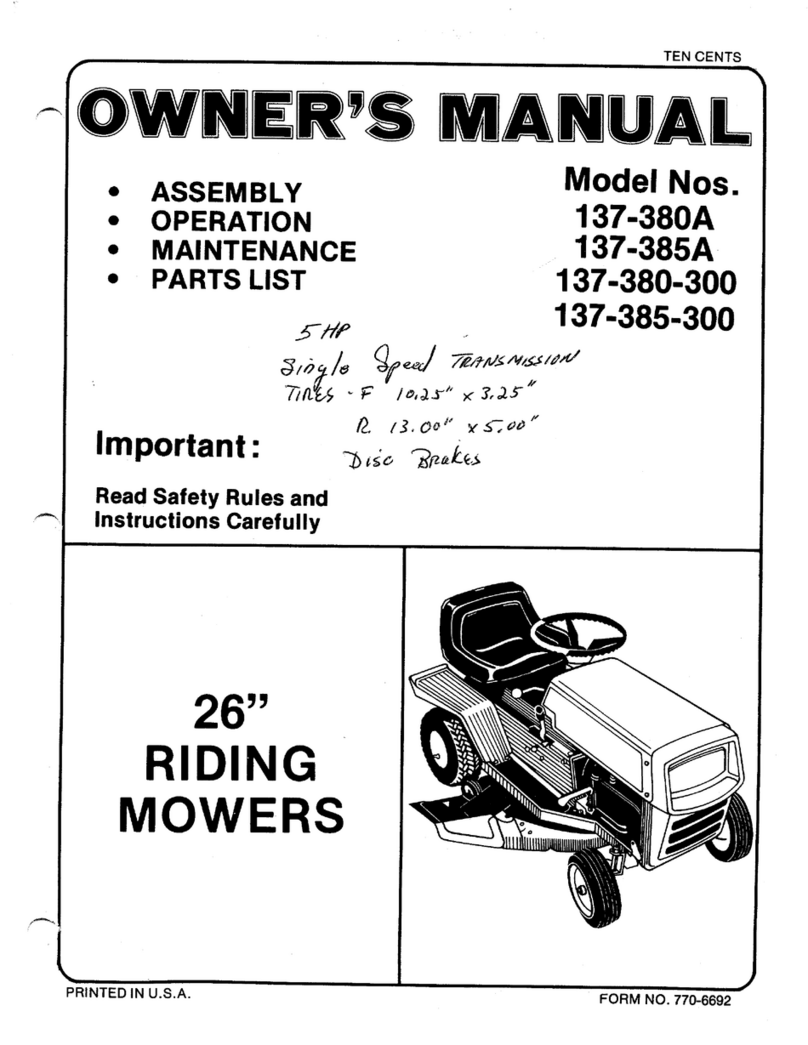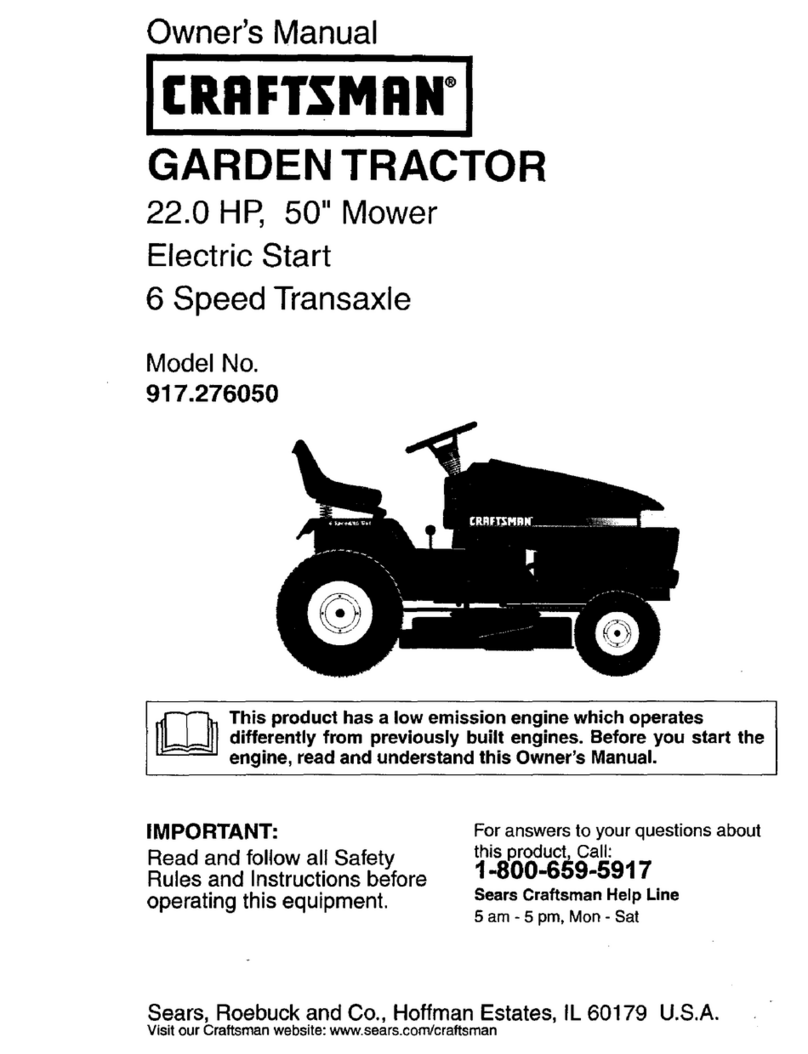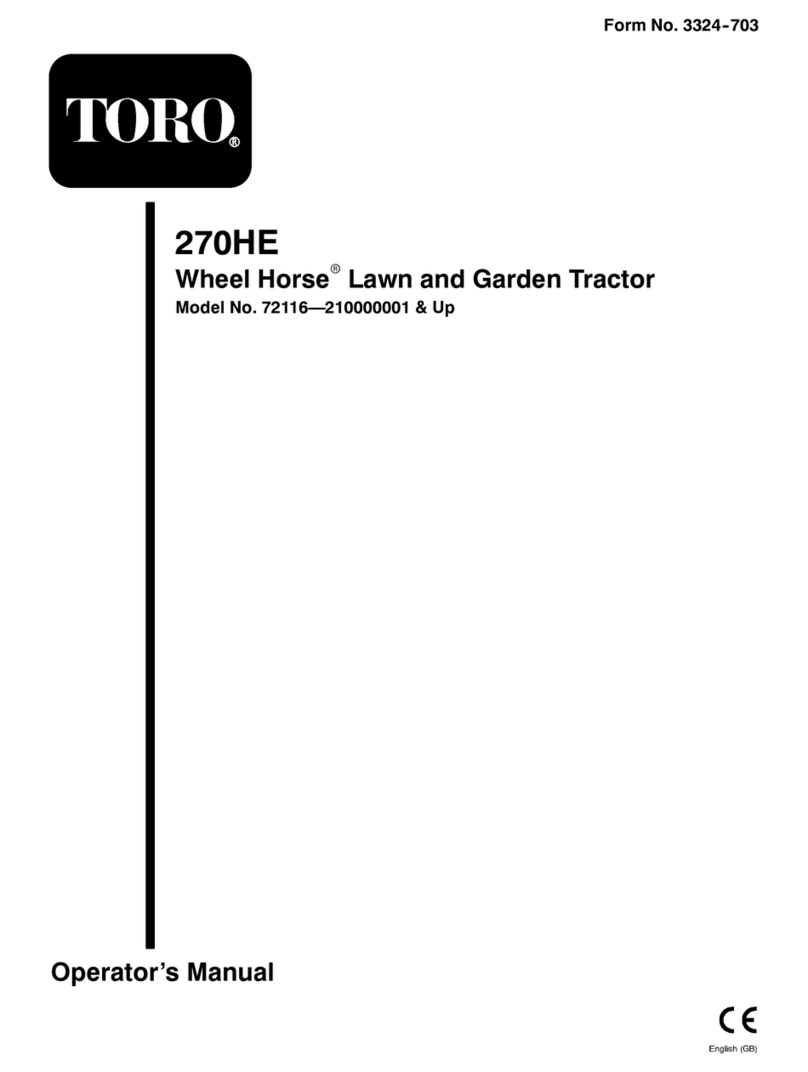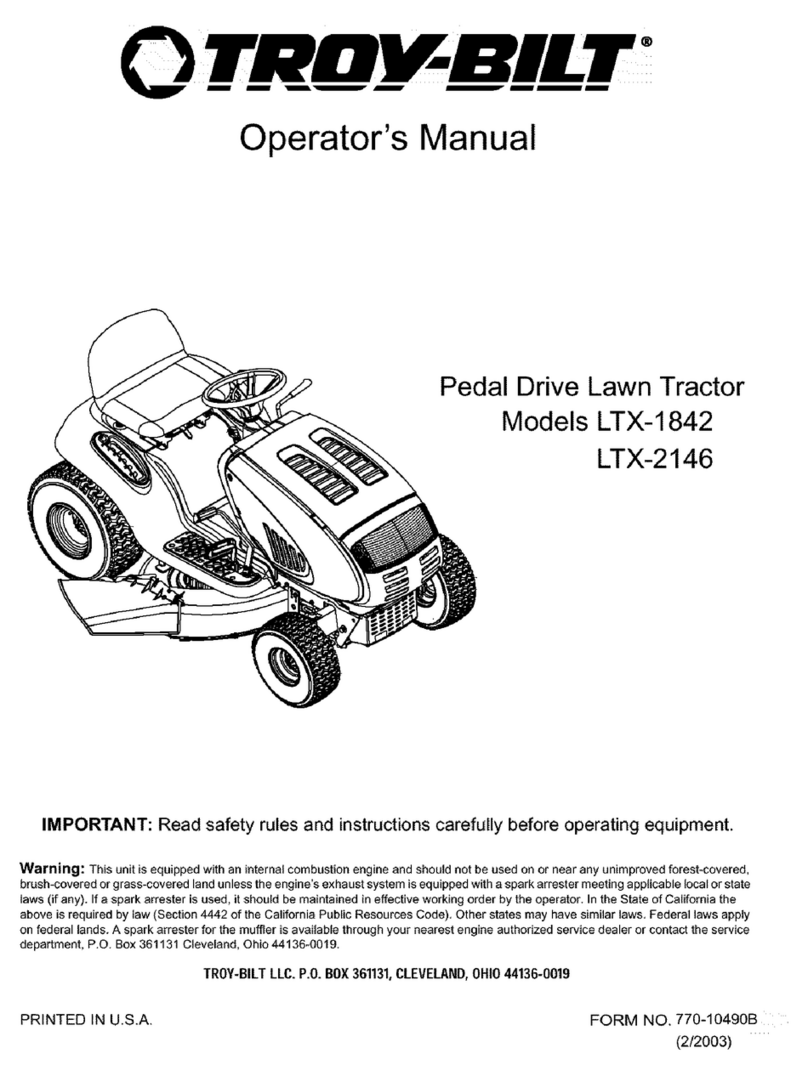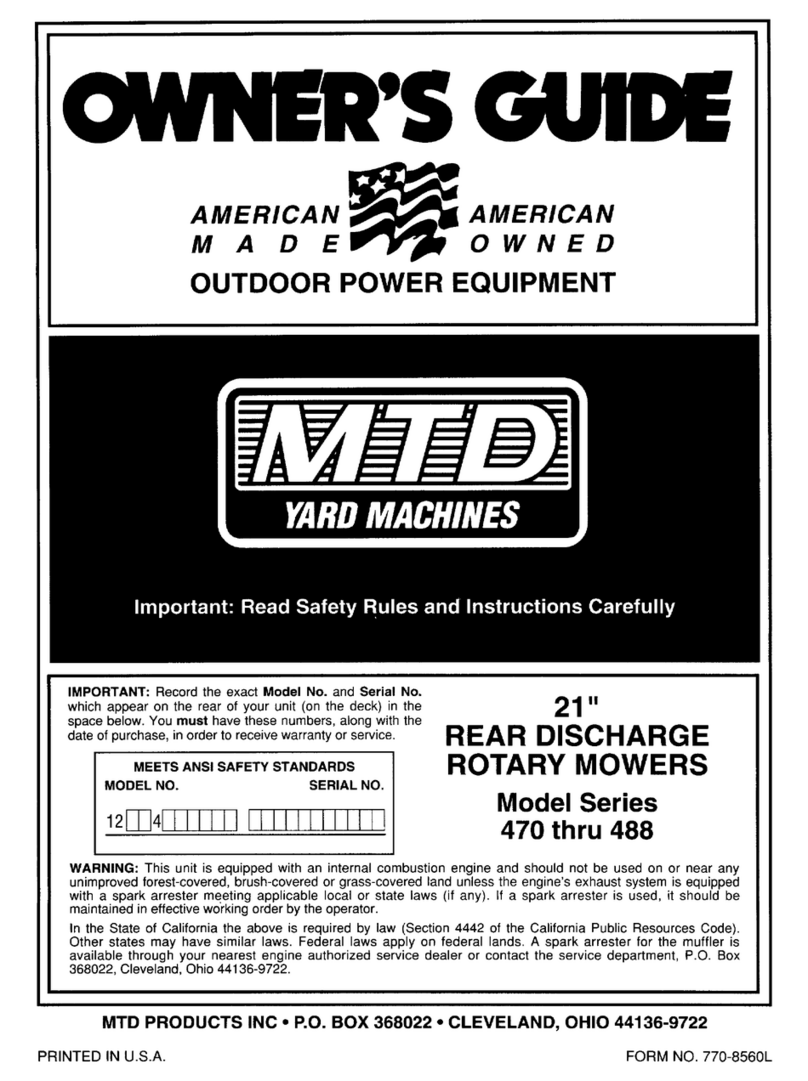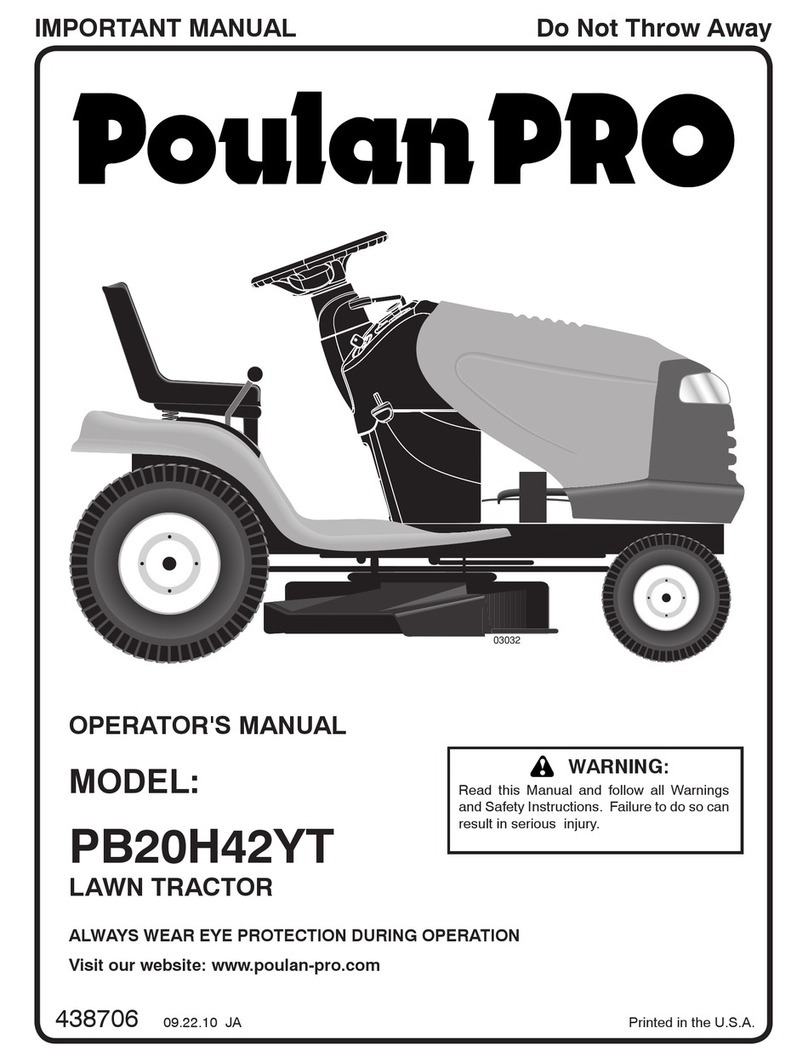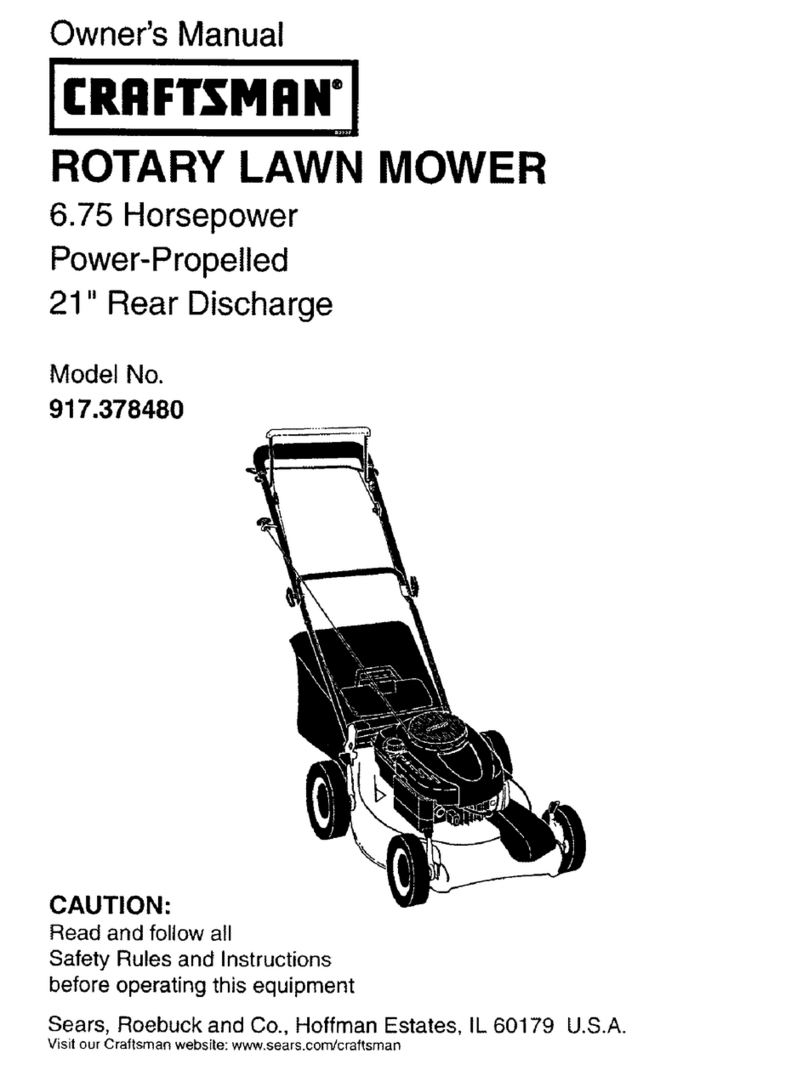FGM TC 155 GTI User manual


TABLE OF CONTENTS
INTERNATIONAL SYMBOLS 1
SAFETY RULES 2
ASSEMBLY 4
OPERATION 9
MAINTENANCE 16
ADJUSTMENTS 21
WIRING ` 27
TROUBLESHOOTING GUIDE 29
STORAGE 31
TECHNICAL SPECIFICATIONS 32
Read this manual carefully so that you will know how to assemble, use and maintain this unit, Fill in and mail
the registration card provided with the unit. For service other than described in this manual, contact an
authorized service dealer. He will provide you with parts and service.
NOTE: This lawn tractor is equipped with a combustion engine, which should not be used near any land covered
with grass or brush, unless the engine's exhaust system is equipped with a spark arrester meeting local laws.
The operator should maintain the spark arrester in effective working order.
INTERNATIONAL SYMBOLS
These symbols appear on your unit and in the supplied documentation.
You should learn and understand their meaning.
1

SAFETY RULES
THESE INSTRUCTIONS ARE FOR YOUR PROTECTION. YOU SHOULD READ THEM CAREFULLY
WARNING: THIS LAWN TRACTOR IS ABLE TO CUT HANDS, FEET AND THROW OBJECTS. IF YOU DO
NOT FOLLOW THE SAFETY INSTRUCTIONS, YOU COULD EXPERIENCE SERIOUS INJURIES.
1. GENERAL OPERATION: 2. SLOPE OPERATION:
*KNOW CONTROLS AND HOW TO STOP QUICKLY. SLOPES ARE A MAJOR FACTOR RELATED TO LOSS OF CONTROL
*READ, UNDERSTAND AND FOLLOW ALL INSTRUCTIONS AND TIP OVER ACCIDENTS, WHICH CAN RESULT IN SEVERE
IN THE AND ON THE MACHINE BEFORE STARTING. INJURY OR DEATH. ALL SLOPES REQUIRE EXTRA CAUTION.
*ONLY ALLOW RESPONSIBLE ADULTS, WHO ARE FAMILIAR IF YOU CAN NOT BACK UP THE SLOPE OR IF YOU FEEL UNEASY
WITH INSTRUCTIONS TO OPERATE THE MACHINE. ON IT, DO NOT MOW IT.
*WEAR SAFETY GLASSES OR EYE SHIELDS WHEN DO !
ASSEMBLING OR OPERATING THE MACHINE *MOW UP AND DOWN, NOT ACROSS
*DO NOT OPERATE MACHINE WHEN BAREFOOT. ALWAYS *REMOVE OBSTACLES SUCH AS ROCKS, TREE LIMBS, ETC.
WEAR SUBSTANTIAL FOOTWEAR, PREFERABLY STEEL TOED SHOES. *WATCH FOR HOLES, RUTS OR BUMPS. UNEVEN TERRIAN COULD
*DO NOT WEAR LOOSE FITTING CLOTHING THAT COULD OVERTURN THE MACHINE. TALL GRASS CAN HIDE OBSTACLES.
GET CAUGHT IN MOVING PARTS. *USE SLOW SPEED. CHOOSE A LOW GEAR SO THAT YOU WILL NOT HAVE
*CLEAR THE AREA SUCH AS ROCKS, TOYS, WIRES, ETC., TO STOP OR SHIFT WHILE ON SLOPE.
WHICH COULD BE PICKED UP AND THROWN BY BLADES. *FOLLOW THE MANUFACTURER'S RECOMMENDATIONS FOR WHEEL
*BE SURE THE AREA IS CLEAR OF PEOPLE WHEN MOWING. WEIGHTS OR COUNTERWEIGHTS TO IMPROVE STABILITY.
*STOP MACHINE IF ANYONE ENTERS THE AREA. *USE EXTRA CARE WITH GRASS COLLECTOR OR OTHER ATTACHMENTS.
*NEVER CARRY PASSENGERS. THIS CAN CHANGE THE STABILITY OF THE MACHINE.
*DO NOT MOW IN REVERSE UNLESS NECESSARY. *KEEP ALL MOVEMENTS ON THE SLOPE SLOW AND GRADUAL.
*ALWAYS LOOK DOWN AND BEHIND BEFORE AND *DO NOT MAKE SUDDEN CHANGES IN DIRECTION OR SPEED.
DURING BACKING UP. *AVOIC STARTING OR STOPPING ON A SLOPE. IF TIRES LOSE TRACTION
*BE AWARE OF MOWER DISCHARGE AND DO NOT POINT TURN OFF THE BLADES AND PROCEED SLOWLY DOWN THE SLOPE.
IT AT ANYONE.
*DO NOT OPERATE MOWER WITHOUT THE ENTIRE GRASS DO NOT !
COLLECTOR. *DO NOT TURN ON SLOPES UNLESS NECESSARY, AND THEN
*SLOW DOWN BEFORE TURNING. SLOWLY AND GRADUALLY DOWNHILL, IF POSSIBLE.
*NEVER LEAVE A RUNNING MACHINE UNATTENDED *DO NOT MOW NEAR DROP-OFF DITCHES OR EMBANKMENTS
ALWAYS TURN OFF BLADES, SET PARKING, STOP ENGINE THE MOWER COULD SUDDENLY TURN OVER IF A WHEEL IS
*AND REMOVE KEYS BEFORE DISMOUNTING. OVER THE EDGE OF A CLIFF OR DITCH, OR IF AN EDGE
*TURN OFF BLADES WHEN NOT MOWING. CAVES IN.
*STOP ENGINE BEFORE REMOVING GRASS COLLECTOR. *DO NOT MOW ON WET GRASS. REDUCED TRACTION COULD
*MOW ONLY IN DAYLIGHT OR GOOD ARTIFICIAL LIGHT. CAUSE SLIDING.
*DO NOT OPERATE THE MACHINE WHILE UNDER THE *DO NOT TRY TO STABILIZE THE MACHINE BY PUTTING YOUR
INFLUENCE OF ALCOHOL OR DRUGS. FOOT ON THE GROUND.
*WATCH FOR TRAFFIC WHEN OPERATING NEAR OR
WHILE CROSSING ROADWAYS.
*USE CARE WHEN MOVING AROUND A FIXED OBJECT
TO PREVENT THE BLADES FROM STRIKING IT. NEVER
DELIBERATELY RUN OVER ANY FOREIGN OBJECT.
*USE EXTRA CARE WHEN LOADING OR UNLOADING
THE MACHINE INTO A TRAILER OR TRUCK.
*USE CARE WHEN PULLING LOADS OR USING HEAVY
EQUIPMENT.
aUSE ONLY APPROVED DRAWBAR HITCH POINTS.
bLIMIT LOADS TO THOSE THAT YOU CAN SAFELY CONTROL
cDO NOT RUN SHARPLY. USE CARE WHEN BACKING.
dUSE COUNTERWEIGHTS, WHEEL WIEIGHT WHEN SUGGESTED
IN ATTACHMNENTS INSTRUCTIONS.
THIS SYMBOL MEANS THAT IMPORTANT SAFETY PRECAUTIONS HAVE TO
BE
POINTED
OUT
.
YOUR
SAFETY
IS
INVOLVED
.
2

SAFETY RULES
3. CHILDREN: 4. SERVICE:
TRAGIC ACCIDENTS CAN OCCUR IF THE OPERATOR IS NOT *USE EXTRA CARE IN HANDLING GASOLINE AND OTHER FUELS.
ALERT TO THE PRESENCE OF CHILDREN. CHILDREN ARE aUSE ONLY AN APPROVED CONTAINER.
OFTEN ATTRACTED TO THE MACHINE AND THE MOWING bNEVER REMOVE GAS CAP OR ADD FUEL WITH THE ENGINE RUNNING.
ACTIVITY. NEVER ASSUME THAT CHILDREN WILL REMAIN cNEVER REFUEL THE MACHINE INDOORS.
WHERE YOU LAST SAW THEM. dNEVER STORE THE MACHINE OR FUEL CONTAINER INSIDE WHERE THERE
*KEEP CHILDREN OUT OF THE MOWING REA AND UNDER IS OPEN FLAME, SUCH AS IN A WATER HEATER.
WATCHFUL CARE OF ANOTHER RESPONSIBLE ADULT. *CHECK FUEL SUPPLY BEFORE EACH USE ALLOWING SPACE FOR EXPANSION
*BE ALERT AND TURN MACHINE OFF IF CHILDREN ENTER AREA. AS THE HEAT OF THE ENGINE AND SUN CAN CAUSE GASOLINE TO EXPAND
*BEFORE AND WHEN BACKING, LOOK DOWN AND BEHIND FOR CHILDREN. AND OVERFLOW THE TANK.
*NEVER CARRY CHILDREN. THEY MAY FALL OFF AND BE SERIOUSLY *USE EXTRA CARE WHEN HANDLING BATTERY ACID. ACID CONTACT WITH
INJURED OR INTERFERE WITH SAFE MACHINE OPERATION. SKIN MAY CAUSE SEVERE BURNS. EYE CONTACT MAY CAUSE BLINDNESS.
*NEVER ALLOW CHILDREN TO OPERATE THE MACHINE. *USE EXTRA CARE WHEN SERVICING THE BATTERY. EXPLOSIVE GAS IS
*USE EXTRA CARE WHEN APPROACHING BLIND CORNERS, SHRUBS, PRODUCED IN THE BATTERY. DO NOT SERVICE THE BATTERY WHILE
TREES OR OTHER OBJECTS THAT MAY OBSCURE VISION. SMOKING OR NEAR AN OPEN FLAME. THIS MAY CAUSE THE BATTERY
TO EXPLODE CAUSING SERIOUS INJURY.
*NEVER RUN A MACHINE INSIDE A CLOSED AREA. EXHAUST FUMES CONTAIN
CARBON MONOXIDE, AND ODOURLESS AND DEADLY GAS.
*KEEP NUTS AND BOLTS, ESPECIALLY BLADE ATTACHMENT BOLTS, TIGHT
AND KEEP EQUIPMENT IN GOOD CONDITION.
*NEVER TAMPER WITH SAFETY DEVICES. CHECK OPERATION REGULARLY.
*DO NOT CHANGE THE ENGINE GOVERNOR SETTINGS OR OVERSPREAD
ENGINE.
*REDUCE FIRE HAZARDS. KEEP MACHINE FREE OF GRASS , LEAVES OR
OTHER DEBRIS BUILD-UP. CLEAN UP OIL OR FUEL SPILLAGE. ALLOW
MACHINE TO COOL BEFORE STORING.
*STOP AND INSPECT THE EQUIPMENT IF YOU STRIKE AN OBJECT. REPAIR IT,
IF NECESSARY, BEFORE RESTARTING.
*NEVER MAKE ADJUSTMENTS OR REPAIRS WITH THE ENGINE RUNNING.
*GRASS COLLECTOR COMPONENTS ARE SUBJECTS TO WEAR, DAMAGE AND
DETERIORATION, WHICH COULD EXPOSE MOVING PARTS OR ALLOW OBJECTS
TO BE THROWN. FREQUENTLY CHECK COMPONENTS AND REPLACE WITH
MANUFACTURER'S RECOMMENDED SPARE PARTS. WHEN NECESSARY.
*MOWER BLADES ARE SHARP AND CAN CUT. WRAP THE BLADES OR WEAR
GLOVES, AND USE EXTRA CAUTION WHEN SERVICING THEM.
*CHECK BRAKE OPERATING FREQUENTLY. ADJUST AND SERVICE AS NEEDED.
3

ASSEMBLY
UNPACKING STEERING WHEEL (Fig. 2)
The tractor is not completely assembled at
the factory, for transportation reasons.
After removing the packaging, check the
machine for any damage during the shipment,
locate the hardware bag and loose parts. Take
care while removing the machine from the pallet,
to avoid any damage on the mower deck.
STANDARD PACKIN
G
*tractor
*steering wheel
*seat with fasteners
*battery Fig. 2
*grass catcher
*trailer hitch - optional Proceed to the following steps:
*bag with owner's manual ,engine manual, 2 keys 1. Straighten the front wheels.
for ignition, 1 decal with an arrow. 2. Align the holes of the steering wheel (pos. 1) with the
*hardware bag for grass catcher the hole in the steering shaft (pos. 2).The steering
wheel bar closest to the operator's seat has to be
IDENTIFICATION aligned with the lengthwise axis of the tractor.This
orientation of the steering wheel makes all the
The tractor identification plate is located control elements located on the dash panel
under the driver's seat and behind the easily visible.
battery. Make a note of the serial number 3. Insert the lock pin (pos. 3) through the holes,
on this page. This serial number will have and drive it throught the holes with a
to be quoted when contacting your hammer.
distributor for service and ordering spare
parts for the tractor. See Fig. 1. SEAT (Fig. 3)
Serial No ...............................................
Fig. 3
Proceed to the following steps:
1. Discard the plastic cover from the seat
2. Take off both the adjustment knobs
and both hex flange bolts.
Fig. 1: Identification plate 3. Place the seat and tighten securely with
two bolts, flat and spring washers.
4. Connect the safety switch (Fig. 3).
4

ASSEMBLY
TRAILER HITCH (Fig. 4) The grass collector has been partially assembled.
To final assemble it correctly (to fit the
collector cover with tractor fenders), it is
recommended to follow the instructions below:
1. Take all parts of grass collector out from paper box
including the partially assembled collector.
2. Lay the assembly down on level surface facing down
the plastic collector cover (pos. 28). Make sure
not scratching plastic collector cover from outside.
3. Open the front frame assembly (pos. 8) to align holes
on the top frame assembly (pos. 26). Insert bolts
(pos. 22) and tight the nuts (pos. 3).
Fig. 4
4. Using bolt (pos. 14) and nut (pos. 3) tighten the front
Note: If your tractor is equipped with the optional frame assembly on the bottom frame assembly.
trailer hitch then proceed to the following steps:
5. Insert corner support (pos. 10) and (pos. 15) between
1. Place trailer hitch in place. top frame assembly (pos. 18) to fit on outside part
2. Install supplied bolts, washers and nuts. Tighten of tubes. Tighten them by bolts (pos. 14) and nuts
securely. (pos. 3). Be careful about the right placement
of corner supports.
GRASS COLLECTOR BAG (Fig. 5
)
6. Tilt down the braces (pos. 20).
7. Place the connecting brace (pos. 16) on the outside
of the bag (pos. 9) and tighten it together with braces
(pos. 20) using bolts (pos. 17) and nuts (pos. 3).
8. Insert the dumping lever (pos. 7) through the hole
of the collector cover (pos. 28) and secure it with
the screw (pos. 29). Recommendation: to make
the assembling easier you can make the thread
into the dumping lever by using the screw (pos. 29)
before inserting dumping lever (pos.7) through
collector cover (pos. 28).
9. Check out the tightness of grass collector bag (pos. 9)
and placing of washer (pos. 11) and (pos. 13) on right
places and tighten well nuts (pos. 3).
10. Use the plastic extrusions of collector bag (pos. 9)
on the side and bottom part of front frame assembly
(pos. 8).
Fig. 5
5

ASSEMBLY
PLACING THE GRASS COLLECTO
R
ON THE TRACTOR (Fig. 6)
.
Fig. 7
Fig. 6
Proceed to the following steps: WARNING
1. Lift the grass collector assembly with This tractor is equipped with a safety
both hands. Slant it to an angle of micro-switch and the cutting system will
approximately 40 degrees (Fig. 6). not function when the grass collector
assembly is not in place. Do not tamper
2. Slide the grass catcher on the two with this microswitch.
support brackets located on the rear collector
plate of the tractor. Check out the alignment
of grass collector cover to the fender. In case PREPARATION BEFORE THE FIRST OPERATION
it is not fitting precisely adjust the position
of grass collector using the movement The tractor is shipped without gas
of the braces on the slots or by light bending for safety reasons.Check oil level.
of the braces. Fill fuel tank with reccommended gas.
3. When the grass catcher is properly
positioned, place the decal with the DANGER
triangle symbol directly opposite to the
symbol on the rear of the tractor. This Lead acid batteries generate explosive
will assist alignment in the future (Fig. 7). gases. Keep sparks, flame and smoking
materials away from batteries. Always wear
eye protection when around batteries.
6

ASSEMBLY
BATTERY PREPARATIO
N
Maintenance-free battery is delivered dry (without electrolyte).
The electrolyte is delivered in two bottles together with
machine. The battery is placed under the seat. Thanks to
its cover it is waterproof and up angle 45° it is sealed
against leakage, so the electrolyte do not leak under
standard usage.
CHARGE BATTER
Y
1. Loose wire battery holder.
2. Disconnect black electric wire (“-“pole).
3. Disconnect red electric wire (“+“pole). Fig. 8
4. Take the battery out of the tractor.
DANGE
R
5. Take off covers from top of the battery.
Electrolyte is a dangerous acid and
6. Slowly fill the electrolyte into each battery cell until poisonous. Always wear eye protection
it is full up to lower end of tube. Protect your skin when handling acid or battery
7. Connect 12 volt battery charger to the battery. POISON/DANGER-CAUSES SEVERE
Charge the battery with 2 amps for 4 hours. Do not BURNS
overcharge the battery. Disconnect battery charger
when the battery is fully charged and close battery Contains sulfuric acid.
cells with covers. Avoid contact with skin, eyes or clothing
To prevent accidents, neutralize excess acid
8. Put the battery back to the tractor and connect it to with baking soda and rinse empty container with water
electric wires – first to the red one and then to
the black one.
A
NTIDOT
E
9. Cover the poles with rubber cover. EXTERNAL: Flush with water
INTERNAL: drink large quantities of water or milk.
10. Fasten the battery with wire battery holder. Follow with milk of magnesia, beaten
eggs or vegetable oil.
CALL A PHYSICIAN IMMEDIATELY
EYES: Flush with water for 15 minutes and
get prompt medical attention.
KEEP OUT OF THE REACH OF CHILDREN
TO SERVICE THE ENGINE
NOTE: The engine is shipped with oil!
If oil needs to be added or changed then fill crankcase with
SAE 10w-30 oil. (See engine Operation Manual).
Do not overfill or it will cause serious damage
to the engine.
Before starting the engine, read carefully
the engine manual.
7

ASSEMBLY
GAS FILLING DANGE
R
Use extra care in handling fuels. They are
flammable, vapors are explosive. Allow the
engine to cool down before refuelling. Do
not smoke. Use safety approved container
only to store your gasoline!
In the engine owner's manual, you will find fuel and
oil recommendations.
TYRES
Proceed to the following steps:
Fig. 9
1. Check the tyre pressure :
(1.0 BAR) for the front wheels: 100 kPa
Use only regular unleaded gasoline. (0.8 BAR) for the rear wheels. 80 kPa
The recommended lowest octane level is 95.
If the engine runs on gasoline with a lower 2. Adjust pressure up or down if necessary (Fig.10).
octane level than 95, an effect known as
knocking can arise. This engine temperature NOTE: The tyre pressure is important for
occurs when reached operating level and can an even cut.
cause engine failure.
REFUELLING
WARNING
Make sure there is good air ventilation
when refuelling.
1. Stop the engine and let it cool down.
2. Open the gasoline cap slowly in order to
release any possible high pressure.
3. Tighten the gasoline cap carefully after refuelling. Fig. 10
4. Dry fuel tank around the area of the gasoline cap.
Clean the tank regularly. Impurities in the tank
can cause operating problems.
For refuelling, use an approved container with
funnel. Do not overfill the tank, which contains
approximately 8 litres.
8

OPERATION
CONTROLS (Fig. 11) OPERATION AND DESCRIPTION
1. Dash panel Toggle switch cutting system (Fig.11, pos.5).
2. Throttle control lever (15.5HP & 16HP) To engage, push the mower system down on the rocker
or throttle control knob (18HP) switch and place it in the ON position: this actuates
3. Choke control (only 18HP) the cutting system clutch which drives the blades.
4. Ignition switch
5. ON/OFF switch cutting system When the collector is full with grass the overload
6. Service hour meter (only 16HP & 18HP) protection switch located inside the grass collector
7. DC AMMETER (only 16HP & 18HP) will be mechanically activated and the warning buzzer
8. Engine oil pressure light (only 20HP Honda) will come on. The buzzer is located in the
9. Steering wheel center of the dash panel.
10. Cutting height adjustment lever
11. Forward speed pedal Note:
12. Reverse speed pedal It is highly recommended that when the warning
13. Parking brake lever buzzer is activated to disengage the mower system
14. Brake pedal to prevent the tunnel from being severely clogged.
15. Transmission disengagement lever
9
Fig. 11b
Fig. 11a

OPERATION
SEAT ADJUSTMENT (Fig. 12
)
To start the engine, proceed as follows:
1. Your tractor is equipped with a fuel valve.
To open it the handle should point down as shown
in Fig.13.
In order to adjust the seat, proceed to the
following steps:
1. Loosen the thumb screws.
2. Move the seat forward or backward to
the desired position.
3. Tighten the thumb screws securely.
2. Take a comfortable riding position on
the seat. The safety switch is now connected.
carbon monoxide.
3. Depress fully and hold the brake pedal
(Fig. 14, pos. 1).
10
Fig. 14
TO START THE ENGINE
Fig. 13DANGER
Fig. 12
The temperature of the muffler may exceed 80 degrees C.
Never run the engine indoors, or in enclosed or
poorly ventilated areas. Engine exhaust contains
Keep feet, hands and clothes away from the engine.

OPERATION
4. 15.5HP & 16HP (Fig. 15) - Place the throttle control 6. Turn the ignition key to START
lever in the "choke position". position (Fig.17) release it immediately
18HP (Fig. 16) - Place the throttle control knob when the engine has started.
at the "turtle symbol". Pull the choke control out. Continuous cranking of more that 15
seconds per minute can cause the starter
to overheat. Allow the starter to cool
down for two minutes after cranking of
more than 15 seconds.
7. 15.5HP & 16HP (Fig. 15) - After starting the engine
set the engine speed by the throttle control lever.
18HP (Fig. 16) - After starting the engine push down
the choke control to slow position and set the
engine speed by the throttle control knob.
DANGE
R
When you want to start the engine, be sure that:
5. Check that the "cutting system" is in the OFF position *the brake-pedal is depressed
(Fig. 19). *the mower clutch lever or toggle switch is in the
disengaged position
*the grass collector is properly in place
IMPORTAN
T
Move the throttle to slow position before turning off the
ignition, in order to reduce muffler pop. Failure to do so
will result in engine and exhaust damage.
11
Fig. 17
Fig. 16
Fig. 15

OPERATION
REVERSE GEA
R
WARNING
CAUTION
The mower deck must be in the highest
position, when you drive the tractor in Come to a full stop before changing the direction
transport mode off the lawn. If not, damage of motion.
will be caused to the cutting system
Depress slowly the reverse motion pedal (Fig. 18, pos. 2).
RIDING THE TRACTO
R
WARNING
The tractor is equipped with a hydrostatic
transmission. It means that the forward and While riding backwards, watch out behind.
reverse speed can be achieved with the use Do not have your mower engaged!
of the pedals (Fig. 18).
The more depressed the pedals are the
faster the tractor moves. The tractor moves faster in LAWN CUTTING
forward and slower in reverse.
IMPORTAN
T
*Clear the area of any objects such as toys,
wires, branches, etc.
*Do not wear loose clothes which could be
caught in moving parts.
*Always wear substantial footwear.
* Keep children and animals out of the area
while riding the mower.
*Keep hands and feet away from the
mower deck.
*Never carry passengers.
WARNING
1 - forward pedal In case the tractor must be pushed, the
2 - reverse pedal transmission disengagement by-pass lever
BRAKE (Fig. 14) Be sure the cutting system is disengaged
and is in the OFF position before starting the
When the pedal is fully depressed, the brake engine. (Fig. 19).
is applied. Then, place the throttle at
the "turtle" position (Fig. 15 or Fig.16).
The parking brake lever is used to lock the
brake pedal in brake position (Fig. 14, pos. 2).
12
must be pulled out (Fig. 11, pos. 15).
Fig. 18
Fig. 19

OPERATION
BLADE CHEC
K
RIDING AND MOWING
Check the cutting blades periodically. Proceed with the following steps:
If dull, you will not get a nice even cut.
You must replace or sharpen the blades. 1. Start engine and drive tractor to the lawn.
After sharpening, you must balance the 2. Mower height adjustment in required position (Fig. 20).
blades before re-installation. 3. When on the lawn, engage mower clutch
with toggle switch (Fig. 19).
CUTTING HEIGHT ADJUSTMENT (Fig. 20
)
4. Depress slowly the forward motion pedal to
reach the desired speed.
The cutting height adjustment lever is located on the
right side fender. IMPORTAN
T
The bottom position of the lever is the
lowest cutting height and vice versa. While starting the blades, keep the throttle in
the middle position, to save the belt and clutch
from premature wear and possible damage.
SPEED RANGE
S
The slowest speed is used for mowing on
slopes or mowing high wet grass.
The lower the grass is, the higher the speed can be.
When tractor is used for transport (not cutting),
depress the forward motion pedal for maximum speed
(Fig.18, pos.1).
MOWER DECK GAUGE WHEELS (Fig. 21)
The mower unit might be equipped with four or two
front optional support wheels. The support wheels
are designed for protecting the mower unit if the
ground is uneven.
The mower deck gauge wheels must always be
in the lower position. Refer to Fig. 21.
Before you start mowing, make sure the grass collector
is installed correctly and is in the closed position.
13
Fig. 20
Fig. 21
IMPORTANT

OPERATION
ALWAYS: In case of any obstacles, immediately CATCHER DISCHARGING (Fig. 22
)
disengage the blades and lift the mower deck
to the highest level.
IMPORTAN
T
As soon as the blades strike any solid object,
the shear pins will break. Immediately stop
the engine! Replace the broken shear pins only
with factory original pins. Check to make sure that
all blade mounting bolts are tightened.
MOWING HINTS
1. We advise mowing the lawn in a longitudinal
and cross direction, overlapping previous
cut, which allows the lifting action of the
blades into the cutting path.
2. Forward speed of the lawn tractor must be WARNING BUZZER WHEN COLLECTOR IS FULL
controlled in accordance with the type
and height of grass being mowed. A micro switch located in the collection system controls this
process and, when the grass collector is full, the micro switch
is mechanically activated and the collector warning buzzer
IMPORTAN
T
comes on. In order to avoid clogging the grass collector
disengage the cutting system from ON to OFF position
The taller the grass that must be cut, the slower and the collector warning buzzer will go off. Then reduce the
the forward speed should be. engine to idle, pull out the telescopic dumping lever all the
way and push it down to empty the grass collector, then
slowly pull the lever upwards to allow the grass collector to
SLOPE OPERATION close (grass collector is empty).
*All slopes need extra caution.
*Do not cut grass when slope is more
than 10 degrees (17%).
*Mow slopes riding up and down, never across.
*Avoid sudden changes in direction. NOTE:
*Remove obstacles such as rocks, tree limbs, A. If the holes on the grass collector bag
ruts, etc. are full of grass and are plugged, you must clean
the collector bag by using high pressure water
then leave to dry.
WARNING B. From time to time, clean the area of the cover
of the grass collector switch, mainly the bottom
While travelling downhill - never coast! section.
When parking, depress the brake pedal
and lock it (Fig. 14, pos. 1 and 2).
14
Fig. 22
FUNCTION

OPERATION
TUNNEL CLEANING Turn off the ignition switch, depress the
brake pedal and lock it with the parking
1. Remove the grass collector assy from the back part of brake. Close the fuel valve.
the tractor.
2. Clean the inside of the tunnel all the way to the cutting
pan from the grass. Use a special scraper. IMPORTAN
T
3. Put the grass collector in place again.
Always remove the ignition key before
storing. When storing the tractor for longer
periods of time, disconnect the battery.
HEADLIGH
T
Lights are an integral function of the ignition switch
(Fig.17) TOWING
The tractor is equipped for towing
attachments in the lower rear part
SAFETY CONDITION
S
of the tractor.
The maximum weight for the attachment
The engine cannot start when: is 150 Kg.
a. the seat is not weighted with a driver
b. the break pedal is not fully depressed (Fig. 14)
c. the cutting switch is in ON position (Fig. 19)
STORAG
E
After mowing is finished, lift the mower deck
to the highest position and stop the cutting
system drive.
15

MAINTENANCE
CLEANING ENGINE OPERATION
WARNING Follow the instructions described in the
engine owner's manual for operation and
Before cleaning, washing, servicing or service (air filter, fuel filter, oil change,
repairing, remove the ignition key! spark plugs, etc).
Always wear substantial "steel toe" footwear,
gloves and work clothes.
Be aware of any spilled fuel, oil or other CRANKCASE OIL CHANG
E
contaminating substances.
Crankcase oil should be changed after the
first 5 hours of operation.
After each cut, remove dirt and debris from
the machine surface, the discharge tunnel
and the grass collector. IMPORTAN
T
WASHING (Fig. 23) See engine operating and maintenance
manual for proper procedures.
If your tractor is equipped with an optional oil drain plug
then procced with the following:
1. Place a flat bottom 2 litre container
beneath the oil drain valve (Fig.24).
NOTE: It may be necessary to raise the
left side of the tractor (with blocks under
left wheels) to get proper drainage.
2. Turn the oil drain valve counterclock-wise
and pull to drain oil.
NOTE: The oil fill cap should be loosened
to serve as an air vent.
3. To close oil drain valve, push and turn clockwise.
Fig. 23 4. Fill with grade SAE 30 or SAE 10W-30 oil.
Oil capacity is about 1.4 litres.
(See engine instruction manual)
Proceed with the following: 5. Re-install the oil fill cap.
6. Check that the crankcase oil is at the
1. Wash the tractor on a level surface, with the correct level on the oil dip stick.
grass collector mounted on.
NOTE: Use the optional mower deck mounted
wash-out port if you have this feature.
2. Wash the inside of the mower deck and the
discharge tunnel .
3. Dismount the grass collector, wash it
and leave it "off " the tractor to dry.
4. Clean the plastic parts of the tractor
with a sponge and soapy water.
IMPORTAN
T
Avoid water directly near the switches, dash
or any electrical part.
Fig.24
BE CAREFU
L
To clean the tractor, never use high pressure
washing machines or agressive detergents.
16

MAINTENANCE
Th
e warran
t
y on
thi
s
l
awn
t
rac
t
or
d
oes no
t
cover
it
ems
th
a
t
h
ave
b
een su
bj
ec
t
e
d
t
o opera
t
or a
b
use or
neg
li
gence.
T
o rece
i
ve
f
u
ll
va
l
ue
f
rom
th
e warran
t
y, opera
t
or mus
t
ma
i
n
t
a
i
n
l
awn
t
rac
t
or as
i
ns
t
ruc
t
e
d
i
n
this manual. The following maintenance check list is supplied to assist operator to properly maintain the
lawn tractor. This is a check list only. Adjustments referred to will be found in the adjustment section
of this manual.
MAINTENANCE CHECK LIS
T
SERVICE RECORD
SERVICE
BEFORE STORAGE
BEGINNING EACH SEASON
EVERY 100 HOURS
EVERY 50 HOURS
EVERY 25 HOURS
MONTHLY
FREQUENTLY
AFTER FIRST 20 HOURS
AFTER FIRST 5 HOURS
AFTER FIRST 2 HOURS
BEFORE EACH USE
CHECK ENGINE OIL LEVEL **
CHANGE ENGINE OIL *12*
CHANGE SPARK PLUG **
REPLACE AIR FILTER PAPER CARTRIDGE 12
CLEAN AIR SCREEN 2
INSPECT MUFFLER/SPARK ARRESTER *
REPLACE FUEL FILTER *
CLEAN BATTERY AND TERMINALS **
CHECK BRAKE OPERATION **
CHECK TRANSMISSION *
CHECK TYRE PRESSURE (Fr: 1.0 bar, Rr: 0.8 bar) ** *
SHARPEN OR REPLACE MOWER BLADES 3
CHECK FOR LOOSE FASTENERS **
CLEAN LAWN TRACTOR **
DISCONNECT BATTERY CABLES *
SEE LUBRICATION CHART ** *
ADJUST MOWER COG BELT **
NOTES: 1. Change more often when operating under heavy load or in high temperatures (35 degrees and above). 2. Service
more often when operating in dirty or dusty conditions. 3. Replace more often when mowing in sandy soil.
17

MAINTENANCE
TO BLOCK UP THE TRACTO
R
HOUR METE
R
Note: Your tractor might be equipped with an
When the tractor is to be blocked up, use a optional hour meter. The hour meter will assist
jack to lift it onto support stands. Block up you tabulating a maintenance check list.
the tractor as follows:
1. Place a jack under the rear axle
transmission and lift the rear end of the tractor.
2. Place two stands under the rear axle, one
stand at the inner side of each rear wheel.
3. Lift the front end and place two stands
under the front axle beam, one stand at
the inner side of each wheel spindle.
CAUTION
At no time during maintenance or adjustments,
can the tractor be lifted more than 50 cm
from level position without taking the following
precautions:
1. Remove fuel from the tank and run the
engine until the carburator is dry.
2. Remove battery (See Battery removal
paragraph in the Maintenance section).
3. Remove oil from crankcase.
ENGINE MAINTENANC
E
For information on engine lubrication see the
engine operating maintenance instructions manual.
LUBRICATION SCHEDUL
E
Information on how frequently lubrication
should be carried out, lubrication points
and the type of lubricant are tabulated in
the lubrication schedule below. The
transmission is lifetime lubricated.
18

MAINTENANCE
LUBRICATION SCHEDUL
E
LUBRICATION LIST (Fig. 25)
Item Name Number Term -hours Lubricant
1 Front wheel - grease fitting 2 25 Grease
2 Steering ball-joints 4 50 Oil
3 Steering sector gear 1 50 Grease
4 Steering pinion gear 1 25 Grease
5 Steering shaft bearing 1 50 Oil
6 Steering shaft bearing 1 50 Oil
7 Motion lever 1 50 Oil
8 Shaft hub for lifting the mower deck 1 50 Oil
9 Motion link ball-joints 4 50 Oil
10 Adjustable idler pulley-grease fitting 1 50 Grease
11 Brake pedal hub 2 50 Oil
12 Steering bearing 1 25 Grease
13 Left & Right spindle - grease fitting 2 25 Grease
14 Mower deck hinged pin 6 When dismounted Grease
15 Front axle pivot pin 2 When dismounted Grease
19
Fig. 25
This manual suits for next models
2
Table of contents
Other FGM Lawn Mower manuals
Popular Lawn Mower manuals by other brands

Havener Enterprises
Havener Enterprises BRADLEY MOWERS 36 Owner's manual & parts list
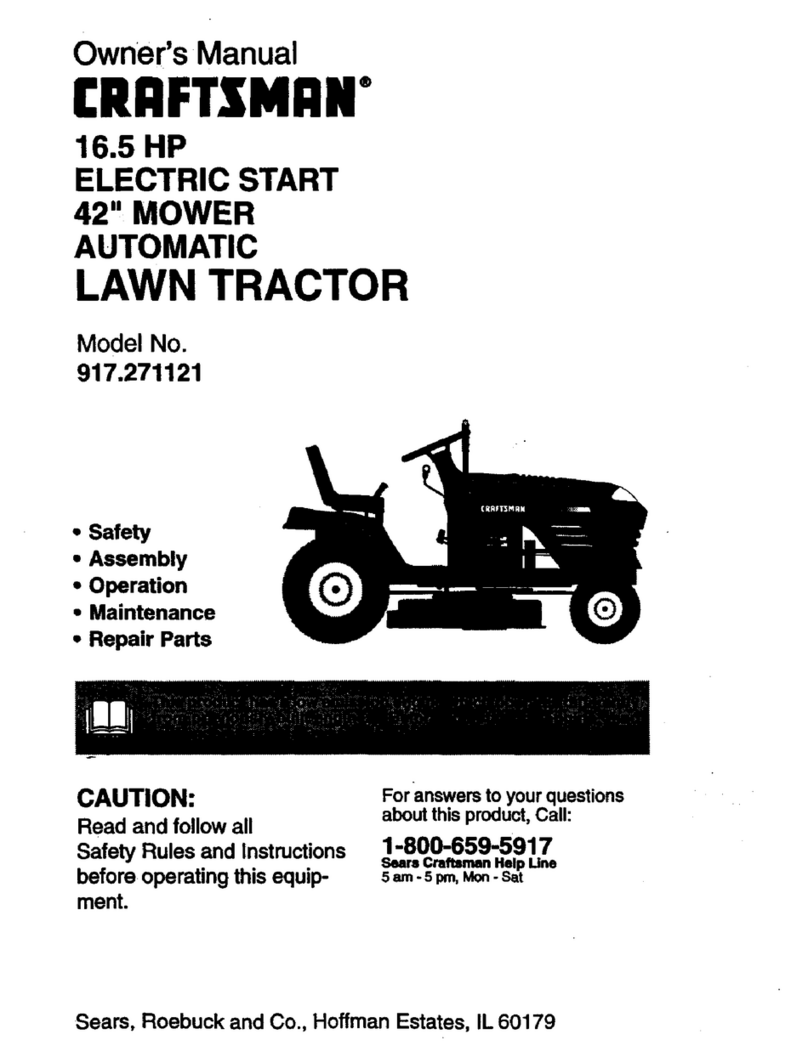
Craftsman
Craftsman 917.271121 owner's manual

Husqvarna
Husqvarna Automower 330X GLUING INSTRUCTIONS
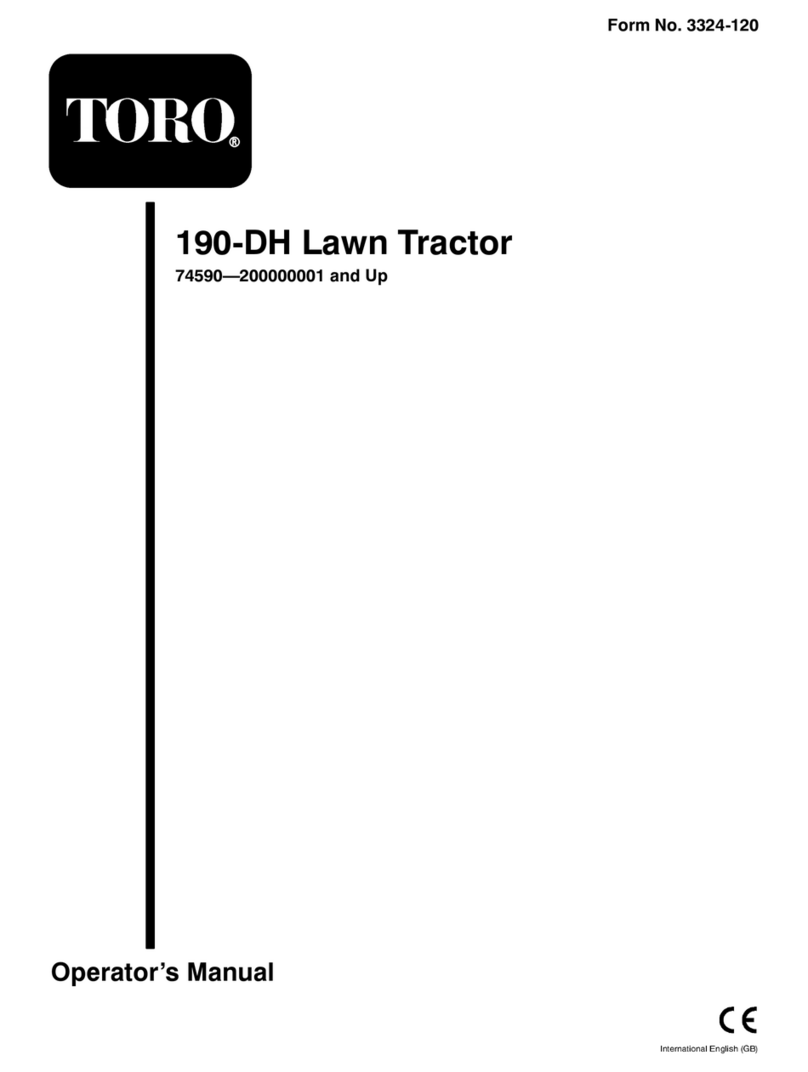
Toro
Toro 74590 Operator's manual
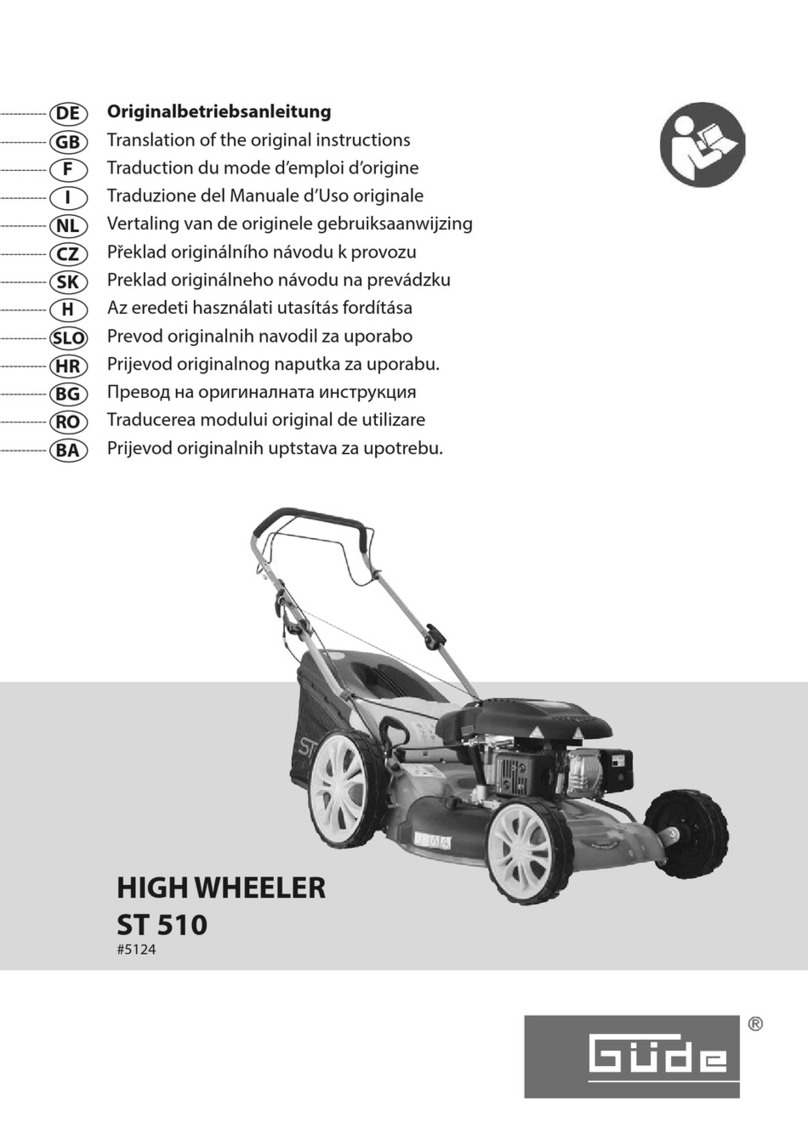
GÜDE
GÜDE HIGH WHEELER ST 510 Translation of the original instructions
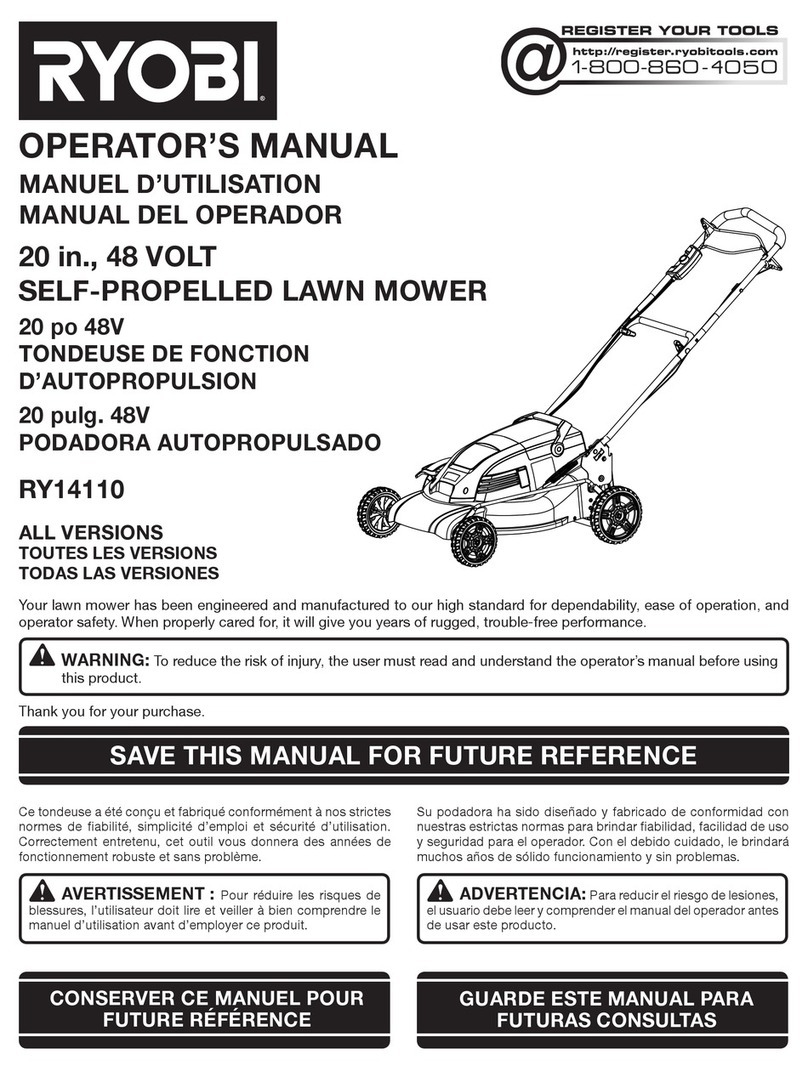
Ryobi
Ryobi RY14110 Operator's manual


